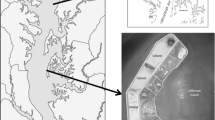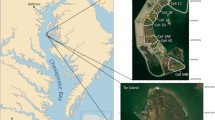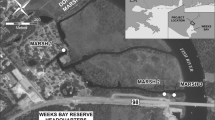Abstract
In natural tidal marshes, nutrient fertilization stimulates complex responses, bringing into question the suitability of nutrient-rich dredged material as a substrate for tidal marsh restoration. We examined vegetation and elevation trends in the constructed tidal marshes at Poplar Island, Maryland where fine-grained dredged material (high nutrient) and locally dredged sand (low nutrient) were used as substrates. Macrophyte production was higher and root:shoot ratios lower in dredged material marshes. Measured vertical accretion was similar in dredged material (7.4 ± 0.6 mm y−1) and sand (6.4 ± 0.9 mm y−1) marshes, and is keeping pace with local sea-level rise. A detailed carbon budget was developed for one dredged material marsh to examine carbon dynamics under high nutrient availability. High annual macrophyte production combined with small exports via tidal exchange and methane emissions resulted in an annual carbon burial of 206 g C m−2 y−1, and calculated vertical accretion of 6.5 mm y−1 from organic matter. This is attributed to the contribution of organic matter from aboveground biomass due to protection from perimeter dikes constructed to contain dredged material during placement, reducing marsh exposure and organic matter export. With appropriate design and management, fine-grained, high-nutrient dredged material makes a suitable substrate for tidal marsh restoration.









Similar content being viewed by others
References
Anisfeld SC, Hill TD (2012) Fertilization effects on elevation change and belowground carbon balance in a Long Island sound tidal mMarsh. Estuaries and Coasts 35:201–211
Barbier EB (2013) Valuing ecosystem services for coastal wetland protection and restoration: Progress and challenges. Resources 2:213–230
Bartlett KB, Bartlett DS, Harriss RC, Sebacher DI (1987) Methane emissions along a salt marsh salinity gradient. Biogeochemistry 4:183–202
Blum LK (1993) Spartina alterniflora root dynamics in a Virginia marsh. Marine Ecology-Progress Series 102:169–169
Boon JD III (1975) Tidal discharge asymmetry in a salt marsh drainage system. Limnology and Oceanography 20:71–80
Cahoon DR, Lynch JC, Hensel P, Boumans R, Perez BC, Segura B, Day JW (2002) High-precision measurements of wetland sediment elevation: I. Recent improvements to the sedimentation-erosion table. Journal of Sedimentary Research 72:730–733
Cahoon DR, Hensel PF, Spencer T, Reed DJ, McKee KL, Saintilan N (2006) Coastal wetland vulnerability to relative sea-level rise: wetland elevation trends and process controls. In: Verheven JTA, Beltman B, Bobbink R, Whigham DF (eds) Wetlands and Natural Resource Management, book 190
Callaway DW, Valiela I, Foreman K, Soucy LA (1995) Effects of nitrogen loading and salt-marsh habitat on gross primary production and chlorophyll-a in estuaries of Waquoit Bay. Biological Bulletin 189:254–255
Chalmers AG, Wiegert RG, Wolf PL (1985) Carbon balance in a salt marsh: interactions of diffusive export, tidal deposition and rainfall-caused erosion. Estuarine, Coastal and Shelf Science 21:757–771
Chmura GL, Anisfeld SC, Cahoon DR, Lynch JC (2003) Global carbon sequestration in tidal, saline wetland soils. Global Biogeochemical Cycles 17
Cornwell JC, Owens MS (2011) Quantifying sediment nitrogen releases associated with estuarine dredging. Aquatic Geochemistry 17:400–517
Cornwell JC, Owens M, Staver LW, Stevenson JC (this volume) Tidal marsh restoration at Poplar Island I: transformation of estuarine sediments into marsh soils. Wetlands this volume
Costa-Pierce BA, Weinstein MP (2002) Use of dredge materials for coastal restoration. Ecological Engineering 19:181–186
Craft CB, Seneca ED, Broome SW (1991) Porewater chemistry of natural and created marsh soils. Journal of Experimental Marine Biology and Ecology 152:187–200
Craft C, Megonigal P, Broome S, Stevenson J, Freese R, Cornell J, Zheng L, Sacco J (2003) The pace of ecosystem development of constructed Spartina alterniflora marshes. Ecological Applications 13:1417–1432
Darby FA, Turner RE (2008) Below- and aboveground biomass of Spartina alterniflora: response to nutrient addition in a Louisiana salt marsh. Estuaries and Coasts 31:326–334
Davis J, Currin C, Morris JT (2017) Impacts of fertilization and tidal inundation on elevation change in microtidal, low relief salt marshes. Estuaries and Coasts 40:1677–1687
Deegan LA (1993) Nutrient and energy transport between estuaries and coastal marine ecosystems by fish migration. Canadian Journal of Fisheries and Aquatic Sciences 50:74–79
Deegan LA, Johnson DS, Warren RS, Peterson BJ, Fleeger JW, Fagherazzi S, Wollheim WM (2012) Coastal eutrophication as a driver of salt marsh loss. Nature 490
Delgado P, Hensel PF, Swarth CW, Ceroni M, Boumans R (2013) Sustainability of a tidal freshwater marsh exposed to a long-term hydrologic barrier and sea level rise. Estuaries and Coasts 36:585–594
Duarte CM, Losada IJ, Hendriks IE, Mazarrasa I, Marbà N (2013) The role of coastal plant communities for climate change mitigation and adaptation. Nature Climate Change 3:961
EA Engineering (2000) Evaluation of dredged material: upper Chesapeake Bay approach channels to the port of Baltimore. Maryland. Final Report prepared for U.S, Army Corps of Engineers, Baltimore, MD
Fleri JR, Lera S, Gerevini A, Staver L, Nardin W (2019) Empirical observations and numerical modelling of tides, channel morphology, and vegetative effects on accretion in a restored tidal marsh. Earth Surface Processes and Landforms DOI. https://doi.org/10.1002/esp.4646
Gao JH, Feng ZX, Chen L, Wang YP, Bai F, Li J (2016) The effect of biomass variations of Spartina alterniflora on the organic carbon content and composition of a salt marsh in northern Jiangsu Province, China. Ecological Engineering 95:160–170
Greenberg AE, Clesceri LS, Eaton AD (eds) (1992) Standard methods for the examination of water and wastewater, vol American Public Health Association; American Water Works Association; Water Environment Federation. Washington, DC
Hanley ME, Bouma TJ, Mossman HL (2019) The gathering storm: optimizing management of coastal ecosystems in the face of a climate-driven threat. Annals of Botany 125:197–212
Kearney MS, Stevenson JC (1991) Island land loss and marsh vertical accretion rate evidence for historical sea-level changes in Chesapeake Bay. Journal of Coastal Research 7:403–415
Kirwan ML, Guntenspergen GR, Morris JT (2009) Latitudinal trends in Spartina alterniflora productivity and the response of coastal marshes to global change. Global Change Biology 15:1982–1989
Kreeger D, Newell R (2000) Trophic complexity between producers and invertebrate consumers in salt marshes, in concepts and controversies in tidal marsh ecology. In. Kluwer Academic Publishers, Dortrecht, The Netherlands
Lane L, Rhoades S, Thomas C, VanHeukelem L (2000) Analytical services laboratory standard operating procedures 2000. Technical Report No. TS-264-00, University of Maryland Center for Environmental Science, Horn Point Laboratory, Cambridge
Langley JA, McKee KL, Cahoon DR, Cherry JA, Megonigal JP (2009) Elevated CO2 stimulates marsh elevation gain, counterbalancing sea-level rise. Proceedings of the National Academy of Sciences 106:6182–6186
Marschner P (2012) Marschner's mineral nutrition of higher plants, Academic Press, London
Mcleod E, Chmura GL, Bouillon S, Salm R, Björk M, Duarte CM, Lovelock CE, Schlesinger WH, Silliman BR (2011) A blueprint for blue carbon: toward an improved understanding of the role of vegetated coastal habitats in sequestering CO2. Frontiers in Ecology and the Environment 9:552–560
MDOTMPA (2018) Annual report to the dredged material management Program executive committee. Maryland Department of Transportation Maryland Port Administration, Baltimore, MD. Available via <https://mpa.maryland.gov/greenport/Documents/dmmpannualreview2018.pdf>
Mendelssohn I (1979) The influence of nitrogen level, form, and application method on the growth response of Spartina alterniflora in North Carolina. Estuaries and Coasts 2:106–112
Middelburg JJ, Barranguet C, Boschker HTS, Herman PMJ, Moens T, Heip CHR (2000) The fate of intertidal microphytobenthos carbon: an in situ 13C-labeling study. Limnology and Oceanography 45:1224–1234
Minello TJ, Zimmerman RJ (1992) Utilization of natural and transplanted Texas salt marshes by fish and decapod crustaceans. Marine Ecology-Progress Series 90:273–285
Morris JT, Bradley PM (1999) Effects of nutrient loading on the carbon balance of coastal wetland sediments. Limnology and Oceanography 44:699–702
Morris JT, Haskin B (1990) A 5-yr record of aerial primary production and stand characteristics of Spartina alterniflora. Ecology 71:2209–2217
Morris JT, Sundareshwar PV, Nietch CT, Kjerfve B, Cahoon DR (2002a) Responses of coastal wetlands to rising sea level. Ecology 83:2869–2877
Morris JT, Sundareshwar PV, Nietch CT, Kjerfve B, Cahoon DR (2002b) Responses of coastal wetlands to rising sea level. Ecology 83:2869–2877
Morris JT, Shaffer GP, Nyman JA (2013a) Brinson review: perspectives on the influence of nutrients on the sustainability of coastal wetlands. Wetlands 33:975–988
Morris JT, Sundberg K, Hopkinson CS (2013b) Salt marsh primary production and its responses to relative sea level and nutrients in estuaries at Plum Island, Massachusetts, and north inlet, South Carolina, USA. Oceanography 26:78–84
Morris JT, Barber DC, Callaway JC, Chambers R, Hagen SC, Hopkinson CS, Johnson BJ, Megonigal P, Neubauer SC, Troxler T, Wigand C (2016) Contributions of organic and inorganic matter to sediment volume and accretion in tidal wetlands at steady state. Earth's Future 4:110–121
Neubauer SC (2008) Contributions of mineral and organic components of tidal freshwater marsh accretion. Estuarine and Coastal Marine Science 78:78–88
Nixon SW (1980) Between coastal marshes and coastal waters - a review of twenty years of speculation and research on the role of salt marshes in estuarine productivity and water chemistry. In: Hamilton P, Macdonald KB (eds) Estuarine and wetland processes with emphasis on modeling, book 11. Plenum Press, New York
Nyman JA, Walters RJ, Delaune RD, Patrick WH (2006) Marsh vertical accretion via vegetative growth. Estuarine Coastal and Shelf Science 69:370–380
Oenema O, DeLaune RD (1988) Accretion rates in salt marshes in the eastern Scheldt, south-West Netherlands. Estuarine, Coastal and Shelf Science 26:379–394
Ouyang X, Lee S (2014) Updated estimates of carbon accumulation rates in coastal marsh sediments. Biogeosciences 11:5057–5071
Owens MS, Cornwell JC (2016) The benthic exchange of O2, N2 and dissolved nutrients using small core incubations. JoVE (journal of visualized experiments):e54098
Payne AR, Burdick DM, Moore GE (2019) Potential effects of sea-level rise on salt marsh elevation dynamics in a New Hampshire estuary. Estuaries and Coasts 42(6):1405–1418
Poffenbarger HJ, Needelman BA, Megonigal JP (2011) Salinity influence on methane emissions from tidal marshes. Wetlands 31:831–842
Redfield AC (1958) The biological control of chemical factors in the environment. American Scientist 46:230A–2221A
Rozas LP, Reed DJ (1993) Nekton use of marsh-surface habitats in Louisiana (USA) deltaic salt marshes undergoing submergence. Marine Ecology-Progress Series 96:147–147
Sallenger AH, Doran KS, Howd PA (2012) Hotspot of accelerated sea-level rise on the Atlantic coast of North America. Nature Clim Change 2:884–888
Sebacher DI, Harriss RC, Bartlett KB (1985) Methane emissions to the atmosphere through aquatic plants. Journal of Environmental Quality 14:40–46
Sparks E, Cebrian J (2015) Effects of fertilization on grasshopper grazing of northern Gulf of Mexico salt marshes. Estuaries and Coasts 38:988–999
Sugimura Y, Suzuki Y (1988) A high temperature catalytic oxidation method for the determination of non-volatile dissolved organic carbon in seawater by direct injection of a liquid samle. Marine Chemistry 24:105–131
Sullivan JJ, Moncreiff CA (1990) Edaphic algae are in important component of salt marsh food-webs: evidence from multiple stable isotope analyses. Marine Ecology Progress Series 62:149–159
Teal JM (1962) Energy flow in the salt marsh ecosystem of Georgia. Ecology 43:614–624
Tong C, Morris JT, Huang J, Xu H, Wan S (2018) Changes in pore-water chemistry and methane emission following the invasion of Spartina alterniflora into an oliogohaline marsh. Limnology and Oceanography 63:384–396
Turner RE (2011) Beneath the salt marsh canopy: loss of soil strength with increasing nutrient loads. Estuaries and Coasts 34:1084–1093
Turner RE, Swenson EM, Milan CS (2000) Organic and inorganic contributions to vertical accretion in salt marsh sediments. In: Weinstein MP, Kreeger DA (eds) Concepts and controversies in tidal marsh ecology. Kluwer Academic Publishing, Boston
Turner RE, Swenson EM, Milan CS, Lee JM, Oswald TA (2004) Below-ground biomass in healthy and impaired salt marshes. Ecological Research 19:29–35
Turner RE, Howes BL, Teal JM, Milan CS, Swenson EM, Goehringer-Toner DD (2009) Salt marshes and eutrophication: an unsustainable outcome. Limnology and Oceanography 54:1634–1642
U. S. Environmental Protection Agency, Chesapeake Bay Program (2019) Chesapeake Bay mean surface salinity (1985–2018). Available via https://www.chesapeakebay.net/what/maps/chesapeake_bay_mean_surface_salinity_1985_2018. Accessed 23 Mar 2020
U.S. Environmental Protection Agency (1979) Methods for chemical analysis of water and wastes. In: United States Environmental Protection Agency OoRaD (ed). USEPA, Cincinnati, OH
U.S. Environmental Protection Agency, Chesapeake Bay Program (2014) Chesapeake Bay watershed agreement. Annapolis, MD. Available via https://www.chesapeakebay.net/documents/FINAL_Ches_Bay_Watershed_Agreement.withsignatures-HIres.pdf
Valiela I, Rietsma CS (1995) Disturbance of salt marsh vegetation by wrack mats in great Sippewissett marsh. Oecologia 102:106–112
Valiela I, Teal J, Sass W (1975) Production and dynamics of salt-marsh vegetation and effects of experimental treatment with sewage sludge - biomass, production and species composition. Journal of Applied Ecology 12:973–981
Valiela I, Teal J, Persson N (1976) Production and dynamics of experimentally enriched salt-marsh vegetation - belowground biomass. Limnology and Oceanography 21:245–252
Weston NB, Porubsky WP, Samarkin VA, Erickson M, Macavoy SE, Joye SB (2006) Porewater stoichiometry of terminal metabolic products, sulfate, and dissolved organic carbon and nitrogen in estuarine intertidal creek-bank sediments. Biogeochemistry 77:375–408
Weston NB, Neubauer SC, Velinsky DJ, Vile MA (2014) Net ecosystem carbon exchange and the greenhouse gas balance of tidal marshes along an estuarine salinity gradient. Biogeochemistry 120:163–189
White DS, Howes BL (1994) Nitrogen incorporation into decomposing litter of Spartina alterniflora. Limnology and Oceanography 39:133–140
Wigand C, Brennan P, Stolt M, Holt M, Ryba S (2009) Soil respiration rates in coastal marshes subject to increasing watershed nitrogen loads in southern New England, USA. Wetlands 29:952–963
Wilson J, Valiela I, Swain T (1986) Carbohydrate dynamics during decay of litter of Spartina alterniflora. Marine Biology 92:277–284
Woodhouse W. W, Jr., Seneca E. D, Broome S. W (1972) Marsh building with dredge spoil in North Carolina. In: Sta. NCSUaRAE (ed) bulletin 445. North Carolina State University, Raleigh
Yozzo DJ, Wilber P, Will RJ (2004) Beneficial use of dredged material for habitat creation, enhancement, and restoration in New York–New Jersey Harbor. Journal of Environmental Management 73:39–52
Zedler JB, Callaway JC (1999) Tracking wetland restoration: do mitigation sites follow desired trajectories? Restoration Ecology 7:69–73
Zimmerman R. J, Minello T. J, Rozas L. P (2000) Salt marsh linkages to productivity of penaeid shrimps and blue crabs in the norther Gulf of Mexico. In: Weinstein M. P, Kreeger D. A (eds) Concepts and controversies in tidal marsh ecology. Kluwer Academic Press, Boston
Acknowledgements
The authors acknowledge the Maryland Department of Transportation Maryland Port Administration, the U. S. Army Corps of Engineers and Maryland Environmental Service for support of this project. Philippe Hensel was instrumental in the installation of SETs. The authors gratefully acknowledge members of the Chesapeake Bay Sentinel Site Cooperative, two anonymous reviewers and Michelle Osborn for suggestions which greatly improved the manuscript, and Taryn Sudol for organizing this special issue. This is contribution #5749 of the University of Maryland Center for Environmental Science.
Author information
Authors and Affiliations
Contributions
LWS, JCS, JCC, NJN contributed to the study conception and design. All authors contributed to field sampling and/or data analysis. LWS drafted the manuscript.
Corresponding author
Ethics declarations
Conflict of Interest
No authors have any financial conflicts of interest or affiliations that might lead to conflicts of interest.
Additional information
Publisher’s Note
Springer Nature remains neutral with regard to jurisdictional claims in published maps and institutional affiliations.
Rights and permissions
About this article
Cite this article
Staver, L.W., Stevenson, J.C., Cornwell, J.C. et al. Tidal Marsh Restoration at Poplar Island: II. Elevation Trends, Vegetation Development, and Carbon Dynamics. Wetlands 40, 1687–1701 (2020). https://doi.org/10.1007/s13157-020-01295-4
Received:
Accepted:
Published:
Issue Date:
DOI: https://doi.org/10.1007/s13157-020-01295-4




